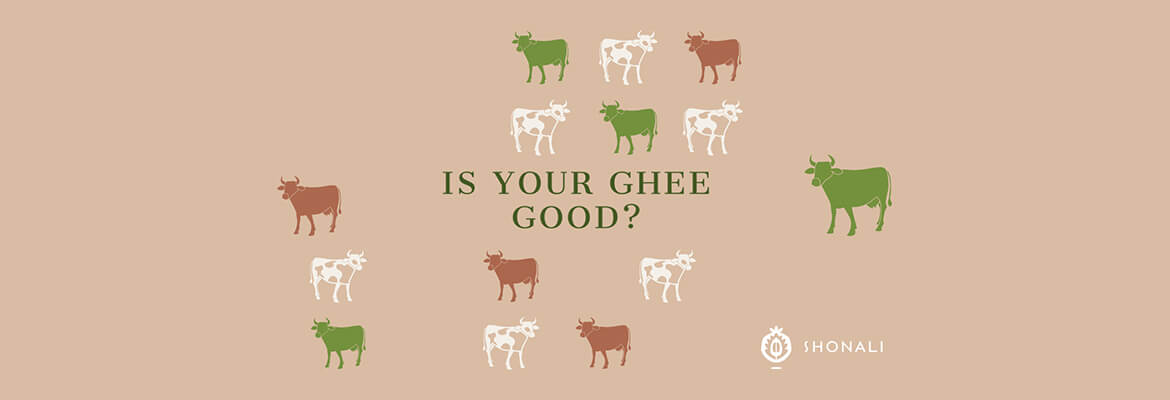Why is GRASS FED COW ghee better?
Note: I am not advocating dairy here, but talking about the ghee that comes from grass fed cow dairy, as all milk solids are removed in the process; making it a good saturated fat to consume.
The way cows are fed can have a huge difference on what they churn out i.e., milk and then that milk used to make ghee. Why cows that have been given a 100% of grass in their feed to churn out dairy, to then make milk is better is due to the nutritional profile of this ghee. The ghee is has a balance of omega 3 omega 6 ratio; higher: vitamin E, beta-carotene, and CLA (five times more Conjugated Linoleic Acid) which the helps immune system, heart and is anti-inflammatory; grass-fed cow dairy is also a rich source of B12, iodine, biotin. vitamin, phosphorus, calcium, selenium, vitamin A. and a richer fatty acid profile. Only grass fed cow dairy has Vitamin K2.
Is GRASS-FED GHEE being sold in India really grass-fed ghee?
Two important determinants come into-play when consuming the raw materials to make ghee i.e., the
- Quality of milk (based on what the cows are fed)
- How it the ghee made i.e., the method used to make it.
Normally in a commercial dairy the feed for cattle is like this:
- Green grass is minimum 20%
- Dry fodder 40% [a by-product of crops after harvesting: wheat, or any grain],
- The balance 40% is a concentrate: which means grain, pulses, or de-oiled cake (crushing oil seeds like groundnut seeds that is by-product of oil seeds).
Know this in India ‘GRASS-FED’ only means that the cattle is being fed a majority of grass in their feed. THERE IS NO INDIAN GOVERNING BODY, THAT CERTIFIES SAYING THE GHEE COMES FROM A GRASS FED cow. THIS IS A BUZZ WORD BEING USED TO SELL THE GHEE. Why? Because its more higher on the nutritional quotient than dairy (read previous post) coming from a cow which is fed more of the concentrate (mentioned in point 3 above) or more of the dry-fodder.
What you should know about ghee extraction –
Most commercial ghee is made from cream, separated from raw milk (using a cream separator which is a centrifugal machine (the heat kills good and bad bacteria) which separates fat from milk, removes cream and then its pasteurized (again killing the bacteria) to make ghee; so the probiotics is missing from it.
For good quality ghee you first make ghee, than extract it using wooden bilona (churner) no heat involved and as a metallic one will heat up, then the butter (makhan) is separated and heated on a low flame, and the ghee is made from this butter (makhan). This process retains the good bacteria (probiotics). Essentially in this process one is changing the raw material from which ghee is made, passing on those benefits i.e., fatty acids profile to a customer.
The difference between A1 Vs A2 ghee
A1 ghee comes from A1 quality milk, from the Holstein and other cow breeds (origin: Australia, USA, Northern Europe) and due to genetic mutation contains a compound called BCM7 the leading cause for many health ailments, opioid, narcotic effects, including cancer.
A2 ghee comes from an old-fashioned cow breed that has not been manipulated (by this I mean bred differently – mutated); similar to human, goat and sheep milk. The claim here is that the quality of casein is better and its absorbability; with no side effects (though this is still not proven completely)
The difference between the two is in 1 amino acid chain and the presence of BCM7.
How to determine how good is your ghee?
Anything that’s coming into your life on a daily basis, I feel you should know about where it comes from and how it’ s made. So what should you do when buying your ghee?
- First visit the farm
- Ask the farm owners: what does your feed comprise off?
- Is the feed organic?
- Determine what process they have used to make their ghee
Good luck! And don’t be fooled by any brand that’s selling off their ghee to you as GRASS FED before you ascertain the above.

